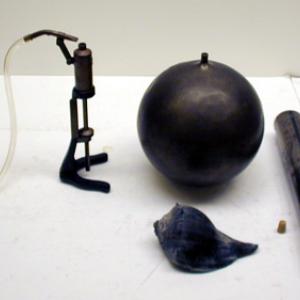College of Liberal Arts & Sciences
3D30.40 - Helmholtz Resonator
No preparation necessary other than occasional oiling of the variable resonator.
CAUTION: The glass resonators are very fragile!!
The Sea Shell is not a Helmholtz Resonator. The air volume of the shell will be exited at the shells resonant frequencies, of which there should be several. This shell has several resonances at frequencies below 300 Hz.
- James Lincoln, "Ten Annoying Experiments to do at Dinnertime", TPT, Vol. 63, #2, Feb. 2025, p. 136.
- Mária Koval’aková, Mária Kladivová, and Zuzana Gibová, "Helmholtz Resonator in Laboratory Experiments", TPT, Vol. 58, #3, Mar. 2020, p. 179.
- Martín Monteiro, Cecilia Stari, Cecilia Cabeza, and Arturo C. Marti, "A Bottle of Tea as a Universal Helmholtz Resonator", TPT, Vol. 56, #9, Dec. 2018, p. 644.
- Martín Monteiro, Arturo C. Marti, Patrik Vogt, Lutz Kasper, and Dominik Quarthal, "Measuring the Acoustic Response of Helmholtz Resonators", TPT, Vol. 53, #4, Apr. 2015, p. 247.
- Thomas B. Greenslade Jr., "Apparatus Named After Our Academic Ancestors, III", TPT, Vol. 52, #6, Sept. 2014, p. 360.
- Mohamed El Abed, "Subwavelength Focalization of Acoustic Waves Using Time Reversal. Yes We Can!", TPT, Vol. 52, #4, Apr. 2014, p. 232.
- Paul Gluck, Sarit Ben-Sultan, and Tamar Dinur, "Resonance in Flasks and Pipes", TPT, Vol. 44, #1, Jan. 2006, p. 10.
- Mark P. Silverman, Elizabeth R. Worthy, "Musical Mastery of a Coke Bottle: Physical Modeling by Analogy", TPT, Vol. 36, # 2, Feb. 1998, p. 70.
- Thomas B. Greenslade Jr., "Experiments with Helmholtz Resonators", TPT, Vol. 34, #4, Apr. 1996, p. 228.
- Thomas B. Greenslade Jr., "The Acoustical Apparatus of Rudolph Koenig", TPT, Vol. 30, #9, Dec. 1992, p. 518.
- H. Richard Crane, "Body Volume Measured by Sound Waves", TPT, Vol. 25, #7, Oct. 1987, p. 454.
- T. S. Natarajan, V. S. Murthy, S. Srinivasan, and S. Radhakrishna, "A Learning Aid in Electronics", TPT, Vol. 23, #1, Jan. 1985, p. 51.
- Paul E. Wack, "A Variable-Volume Helmholtz Resonator", TPT, Vol. 23, #1, Jan. 1985, p. 49.
- Roger P. Blickensderfer, "The Helmholtz Resonator and Log-Log Plots", TPT, Vol. 21, #2, Feb. 1983, p. 111.
- Thomas B. Greenslade, Jr., "Helmholtz Resonators", AJP, Vol. 92, #11, Nov. 2024, p. 858.
- Michael J. Moloney, "Quality Factors and Conductances in Helmholtz Resonators", AJP, Vol. 72, #8, Aug. 2004, p. 1035.
- Bruce Denardo and Miguel Bernard, "Design and Measurements of Variably Nonuniform Acoustic Resonators", AJP, Vol. 64, #6, June 1996, p. 745.
- Bruce Denardo and Steven Alkov, "Acoustic Resonators with Variable Nonuniformity", AJP, Vol. 62, #4, April 1994, p. 315.
- Frank S. Crawford, "Lowest Modes of a Bottle", AJP, Vol. 56, #8, Aug. 1988, p. 702.
- Richard E. Berg, "Another Resonance Tube Demonstration", PIRA News, Vol. 8, #3, Dec. 1993, p. 32.
- G. D. Freier and F. J. Anderson, "Se-3", A Demonstration Handbook for Physics.
- Wallace A. Hilton, "W-4", Experiments in Optical Physics, p. 88.
- R. W. Pohl, Physical Principles of Mechanics and Acoustics, p. 253.
- Jearl Walker, "3.13. Frog Playing a Tree; Cricket Playing a Burrow", The Flying Circus of Physics Ed. 2, p. 151.
- Jearl Walker, "1.49. Seashell Roar", The Flying Circus of Physics with Answers.
- Charles Taylor, "1.18", The Art and Science of Lecture Demonstration, p. 37 - 40.
- R. D. Edge, "7.06. Resonance in Sound", String & Sticky Tape Experiments.
- "19 - 4.5. Helmholtz Resonators", Physics Demonstration Experiments, Vol. 1 and Vol. 2.
- Gerard L'E Turner, Nineteenth-Century Scientific Instruments, p. 142 - 143.
- The Queen Catalogues Vol. II, Catalogue of Physicsal Instruments, No.4578, p. 45.
Disclaimer: These demonstrations are provided only for illustrative use by persons affiliated with The University of Iowa and only under the direction of a trained instructor or physicist. The University of Iowa is not responsible for demonstrations performed by those using their own equipment or who choose to use this reference material for their own purpose. The demonstrations included here are within the public domain and can be found in materials contained in libraries, bookstores, and through electronic sources. Performing all or any portion of any of these demonstrations, with or without revisions not depicted here entails inherent risks. These risks include, without limitation, bodily injury (and possibly death), including risks to health that may be temporary or permanent and that may exacerbate a pre-existing medical condition; and property loss or damage. Anyone performing any part of these demonstrations, even with revisions, knowingly and voluntarily assumes all risks associated with them.
